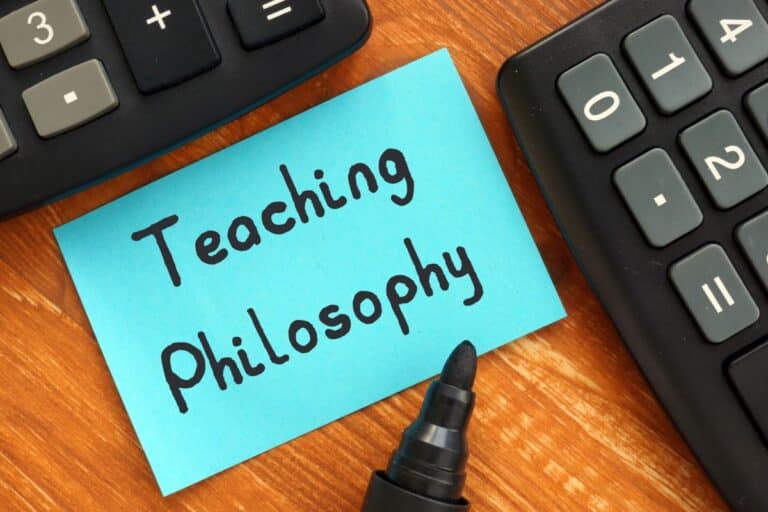A teaching philosophy is a snapshot of why you teach, how you believe students learn, and the daily choices you make to support their growth. When crafted thoughtfully, your philosophy becomes your guide, guiding lesson planning, shaping classroom culture, and even helping future employers or colleagues understand what you bring to the table.
Here we’ll take a closer look at what a teaching philosophy looks like educators, why it matters, and how to create one that is authentic to you.
Why Your Teaching Philosophy Matters
If you’re wondering why you have to have your teaching philosophy written down on paper, the simple answer is for clarity. It helps get your thoughts onto paper and forces you to write down what matters most. It also helps administrators and hiring managers get a glimpse into how you think about teaching and learning. Additionally, it can help you if your lessons ever run off course. It can remind you if your lesson aligns with your beliefs about learning.
Teaching is never static, and neither is your philosophy. Revisit it each year, and it will highlight areas where you have grown as well as spots that need attention.
Key Components of a Strong Teaching Philosophy
There’s no one right way to write a teaching philosophy. However, some components can help paint a clear picture of how you approach teaching and why. Here’s a breakdown of the key parts to include, along with ideas to help you make each one your own.
Beliefs about Student Learning
State how you believe students learn best. Maybe you value hands-on exploration, peer discussion, or personalized feedback. Keep this genuine and specific. “Students learn through meaningful, real-world connections” is stronger than “I believe learning is important.”
The Role of the Teacher
Describe how you see yourself. Are you a facilitator who guides inquiry or a coach who models skills before releasing responsibility?
Example statement:
“I serve as a guide who uses a variety of approaches, asks probing questions, and structures lessons to meet the needs of all students.”
Classroom Environment
Explain the atmosphere you aim to create. Consider physical setup, relationships, and emotional safety. A clear vision here shows that you value community as much as content.
Example statement:
“I will provide an environment where children will use self-discovery, flexible seating, and a hands-on approach to learning.”
Assessment Practices
Connect your beliefs to grading and feedback. Do you emphasize formative checks like exit tickets? Do you provide multiple ways for students to demonstrate learning? Link assessment to growth, not just numbers.
Possible wording:
“To facilitate learning, I will involve students in the process of assessment through rubrics, self-check, and self-evaluation exercises. This will help students develop the ability to judge their accomplishments and set goals for themselves.”
Fairness and Inclusion
Address how you ensure every learner belongs. This might involve differentiating tasks, choosing diverse texts, or using language that reflects students’ identities.
Example statement:
“To meet individual challenges, lessons will be structured into learning modalities by incorporating auditory, kinesthetic, and visual techniques.”
Professional Growth
Close with a nod to ongoing learning. Mention collaboration, research, or professional development that shapes your practice. This shows humility and a commitment to improvement.
Possible wording:
“I believe great teachers never stop learning. I regularly reflect on what’s working and what needs to change. Whether it’s trying a new strategy I read about or tweaking a lesson based on student needs, I’m always working to be a little better than I was the day before.”
How Educators Use a Teaching Philosophy
Now that you know what a teaching philosophy is, why it matters, and what it should look like, it’s time to know how educators use them.
For Job Applications: Administrators use them to get a glimpse into your mindset and whether you’re a good fit for their school district.
Promotion and Tenure: Helps review committees see how your values translate into action. This matters just as much as your lesson plans and test scores.
Self-Reflection: Helps you reflect and see if your current practices align with your philosophy.
Steps to Draft or Refresh Your Teaching Philosophy
If you’re overwhelmed with how to put your beliefs into words, you are not alone. The goal is to try and capture what matters most to you. Here are a few steps to help you get started or revisit what you’ve already written.
Collect Memories and Moments
Think of a few moments in the classroom that stand out to you and jot them down. They can be a strategy that worked or flopped, a chaotic classroom moment, or even a surprise. Then ask yourself what these moments reveal about your beliefs.
Choose Core Values
Next, read what you wrote down and circle anything that repeats or if you see a theme. Choose a few that feel like they align with your core values.
Write a Draft Statement
In one paragraph, connect your values to concrete actions. For instance:
“I believe curiosity drives lasting learning, so I begin units with open-ended questions that spark student investigation.”
Add Evidence
Follow each belief with a brief example. If you value collaboration, mention how literature circles or lab partners appear in your lessons.
Check Tone and Clarity
Read aloud. Does it sound like you? Trim any nonsense and replace broad claims with more vivid details.
Get Feedback
Share with a trusted colleague or mentor. Fresh eyes catch vague language and highlight strengths you might overlook.
Revisit Every Year
Mark a calendar reminder for the first week of summer or winter break. Reflection at predictable intervals keeps your philosophy current.
Sample Mini-Philosophy
“I believe all children deserve a safe, welcoming classroom where they feel valued and supported. I focus on the whole child, social, emotional, and academic growth, while building strong connections with families and the community. I design instruction around students’ individual needs and learning styles, using hands-on activities, technology, and real-world experiences to keep them engaged. My role is to guide, support, and encourage self-discovery, helping students become confident learners. Assessment is part of the learning process, not just a final score. I involve students in reflecting on their growth, setting goals, and taking ownership of their progress. I grow alongside my students by engaging in professional learning communities and reflecting on classroom data.”
Your teaching philosophy is a document that evolves as you evolve as a teacher. Think of it like your roadmap to teaching, helping you navigate along the way.
You’ve got important career goals — we have the graduate program to get you there. Check out our available graduate degree programs to advance your career today!




